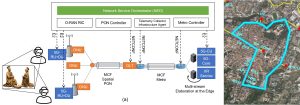A groundbreaking European trial shows how future networks can deliver immersive technologies while saving energy.
The world is standing at the edge of a new digital frontier. Augmented reality (AR) and virtual reality (VR) services, once confined to gaming and entertainment, are rapidly evolving into powerful tools for education, healthcare, manufacturing, and even cultural preservation. Imagine students donning headsets to explore the ruins of ancient Rome, surgeons performing remote procedures with virtual overlays, or architects walking clients through a digital replica of a yet-to-be-built skyscraper.
These experiences demand more than fast internet. They require ultra-low latency, massive bandwidth, and reliable connectivity – all while keeping energy consumption in check. That combination is no small challenge. Current communication networks, largely designed for smartphones and streaming video, are struggling to scale efficiently.
But recent work in Europe, led by the SEASON project, offers a glimpse of how the next generation of networks could meet the demands of immersive technologies. In the Italian city of L’Aquila, researchers and telecom operators have conducted the world’s first field trial of a system that combines spatial passive optical networks (PONs), multicore fibres (MCFs), open radio access networks (O-RAN), and edge computing. The results show that immersive services can be delivered with seamless quality – and up to 11% energy savings – through intelligent orchestration of resources. This achievement matters not only for AR/VR but also for the future of 5G, 6G, and sustainable digital infrastructure.
What makes this breakthrough possible
To understand the significance of this trial, we need to break down its technological foundations into accessible terms.
Multicore fibres and spatial division multiplexing
Traditional fibre optic cables carry light through a single glass core. Multicore fibres (MCFs) contain multiple cores within the same cladding, allowing several light paths to coexist without interference. This approach, known as spatial division multiplexing (SDM), dramatically increases capacity without laying additional cables. It’s a bit like replacing a one-lane highway with a multi-lane expressway: more traffic can flow without expanding the road’s footprint.
Passive Optical Networks (PONs)
PONs are widely used in fibre-to-the-home deployments, where a single optical line terminal (OLT) at the provider’s side serves multiple users through passive splitters. The innovation here is the spatial PON, which can dynamically activate or deactivate lanes within the multicore fibre. When user demand increases, more ‘lanes’ are opened; when demand falls, unused lanes are turned off to save power.
 © shutterstock/TechAnimationStock
© shutterstock/TechAnimationStock
Open RAN and distributed units
In mobile networks, radio access traditionally comes from proprietary, tightly integrated equipment. Open RAN (O-RAN) breaks this model into interoperable components, such as the radio unit (RU) and the distributed unit (DU), managed by an intelligent controller. By monitoring real-time traffic, the system can activate extra small cells only when needed — for example, when multiple VR headsets come online simultaneously.
Edge computing
Instead of routing all data to distant data centres, edge computing brings processing power closer to the users. For AR/VR, this is critical: even a fraction of a second of delay can ruin immersion. In the trial, VR applications were hosted at the edge, allowing real-time rendering with minimal latency.
Orchestration and closed-loop control
The real magic comes from orchestration: co-ordinating all these moving parts. The trial used a network service orchestrator (NSO) to manage the PON controller, O-RAN intelligent controller, metro transport, and telemetry systems. Decisions were made automatically, based on live monitoring, creating a closed-loop system that adapts to demand within seconds.
The L’Aquila Trial: A glimpse into tomorrow’s networks
The trial in L’Aquila wasn’t an experiment run in a lab – it was conducted over a real urban multicore fibre ring, about 6km in length, connecting optical, wireless, and edge infrastructure (See next Fig. 1). Here’s what it consisted of:
Baseline setup: One radio unit (RU) and one PON port supported a VR user streaming content from a virtual museum app.
Scaling up: When a second user joined, traffic monitoring detected the increase. Within seconds, a new RU/DU was activated, an extra spatial lane was opened in the fibre, and an additional PON port was configured.
Energy efficiency: Power consumption rose slightly – from 175W to 197W – but when traffic subsided, resources were automatically deactivated, returning to the baseline. This flexibility translated into an 11% energy saving compared to keeping everything running at full capacity all the time.
Service continuity: Users experienced seamless VR streaming, with no drop in quality during network reconfiguration.
The orchestration process, from traffic detection to reallocation of resources, took less than five seconds. That’s faster than it takes to reload a webpage on a slow connection.
Why energy efficiency matters
At first glance, saving 22W might not sound like much. But scale matters. In dense urban environments, where thousands of small cells and optical nodes may be deployed, even modest savings per unit translate into substantial reductions in electricity consumption — and carbon emissions.
Telecom networks already account for a significant share of global energy use. With 5G rolling out and 6G on the horizon, the challenge is clear: how do we deliver exponentially more data without exponentially more power consumption?
The answer lies in intelligent, demand-driven resource management, as demonstrated in this trial. Instead of building oversized, always-on infrastructure, networks can become adaptive organisms, powering up when needed and powering down when idle.
AR/VR as a test case – and beyond
AR and VR are perfect stress tests for next-generation networks. Their requirements are stricter than those of most current applications, pushing infrastructure to its limits. If a system can support seamless AR/VR, it can handle just about anything else, for example:
Smart cities with real-time sensor integration.
Autonomous vehicles requiring low-latency co-ordination.
Telemedicine with remote diagnostics and surgeries.
Industrial automation where machines collaborate across networks.
 Fig. 1: Reference architecture and field trial setup. The L’Aquila field trial integrated multicore fibre (MCF), spatial passive optical networks (PONs), and open radio access networks (O-RAN) with edge computing. This architecture allowed seamless scaling of resources for immersive AR/VR services while improving energy efficiency
Fig. 1: Reference architecture and field trial setup. The L’Aquila field trial integrated multicore fibre (MCF), spatial passive optical networks (PONs), and open radio access networks (O-RAN) with edge computing. This architecture allowed seamless scaling of resources for immersive AR/VR services while improving energy efficiency
Thus, while the L’Aquila trial focused on immersive applications, its implications extend far wider. It shows that scalable, sustainable connectivity for future digital societies is within reach.
Collaboration at the core
The trial was the result of collaboration among universities, telecom operators, and technology providers across Europe, including CNIT, the University of L’Aquila, UPC, Telefonica, TIM, FiberCop, WestAquila, and Accelleran. Funded under the EU SEASON project, it exemplifies the European approach to innovation: combining academic research, industrial expertise, and real-world deployment.
Such partnerships are essential for tackling the complexity of modern networks. No single player – not even the largest telecom operator – can master all the moving parts alone. By pooling expertise, the project bridged photonics, radio access, edge computing, and orchestration into a unified solution.
Looking toward 6G
While 5G is still rolling out globally, research into 6G is already well underway. If 5G is about connecting everything, 6G will be about sensing, intelligence, and sustainability. Networks will not just transmit data but also gather context, adapt proactively, and integrate with satellite and non-terrestrial systems.
The principles demonstrated in L’Aquila – multicore fibres, spatial multiplexing, dynamic orchestration, and energy-aware design – are likely to play a pivotal role. They align perfectly with 6G’s vision of green, adaptive, and human-centric networks.
Conclusion: Toward sustainable immersion
The field trial in L’Aquila marks a milestone: the first real-world demonstration that immersive technologies like AR/VR can be delivered seamlessly and sustainably through integrated optical-wireless-edge architectures. By dynamically scaling resources, the system achieved both high performance and meaningful energy savings.
As immersive technologies move from niche to mainstream, and as global connectivity demands soar, such innovations will be indispensable. They show that the internet of the future can be not only faster and richer but also smarter and greener. In short: the networks powering our digital future won’t just carry data – they’ll carry services.
Please note, this article will also appear in the 24th edition of our quarterly publication.

